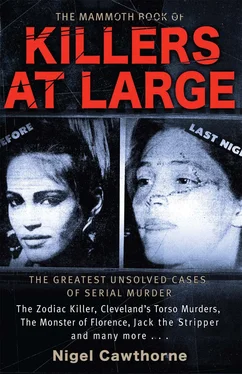On 8 October, another woman’s body was found near Geldenhuis train station, which is one stop from the Cleveland station, on the opposite side of Heriotdale from Jupiter station where Ntombi Makhasi had been found on 3 September. The new victim had clothing stuffed in her mouth and had been strangled with her pantyhose. There were some indications she had been raped, but the body had been lying in the veldt for several days and was badly decomposed.
It was plain that this was the work of the same killer, even though he had dumped the body in a new location. The police then looked back in their files and discovered that two other women’s bodies had been dumped near Geldenhuis station, one on 6 August, the other on 3 September. The modus operandi in the 6 August case was almost identical. The victim was found with her jumper pulled over her head. She had been strangled with her own blouse which was still tied around her throat and her panties and pantyhose had been stuffed into her mouth.
On 13 October, the police offered a reward of 200,000 Rand (£14,000) for information leading to the arrest and conviction of the killer. Four days later, a man identified his daughter from a picture in the newspaper. She was 26-year-old Amanda Kebofile Thethe who was last seen leaving her parents’ home at 9 a.m. on 2 August. She was going to pay a bill in Johannesburg, then go on to Soshanguve, north of Pretoria, some 50 miles away, where she worked as a teacher. As her body had been found on 6 August, she had already been buried in an unmarked grave.
Although the police had repeatedly appealed to the public to report missing persons, Amanda Thethe’s aunt Nomvula Mokonyane spoke out about what had happened when the family had tried to report her niece’s disappearance to the police. A week after Amanda disappeared, they had gone to the police station at John Vorster Plain, Johannesburg, to report her missing, only to be informed that they could not do so due to “lack of stationery” and they were told to go to another station. So they went to the station in Krugersdorp, near where they lived. A week later, when they inquired if any progress had been made, they were told that the file had been mislaid. Plainly, little had changed in the police force since the old apartheid days. However, Mokonyane did praise Brixton Murder and Robbery for their handling of the case since Amanda had been identified.
On 20 October, another victim was identified by her parents. Her name was Malesu Betty Phalahadi. The 25-year-old had last been seen alive on 2 September and was thought to have been travelling by train to visit a friend in Mabopane, near Soshanguve, where Amanda Thethe worked as a teacher. But 2 September was the same day Ntombi Makhasi disappeared. Both Malesu Phalahadi’s and Ntombi Makhasi’s bodies were found the next day Malesu’s near Geldenhuis station; Ntombi’s near Jupiter station.
Curiously, Malesu’s parents had only been alerted to the fact that their daughter might have been the victim of a serial killer when a woman phoned Malesu’s mother Grace Lehlake on 19 October and asked if she knew where her daughter was. As Grace did not, she asked the woman the same question. She replied that Grace should call the police and hung up. Who this woman was remained an intriguing mystery. Was she the friend that Malesu was supposed to be visiting? If so, why did she hide her identity and why did she not contact the police directly? Or was it someone who knew the killer? If so, why wait two-and-a-half months before calling?
But there was another distressing discovery to be made in the case of Malesu Phalahadi. Her fiancé was a local policeman, who found out his lover was dead when he recognized her clothes among the evidence being examined at the Brixton Murder and Robbery Unit.
Both Ntombi Makhasi and Malesu Phalahadi had been intending to head northwards through Pretoria when they had gone missing, so detectives began to throw their net a little wider. They then discovered that there had been two similar cases in Pretoria West, some 30 miles to the north. A woman’s body had found by a cattleman in a patch of open field on 19 August. The same man found a second body about 330 yards from the first on 7 October. Both women were black and neatly dressed. They had been strangled with their stockings and left partially clothed. Once again they had no possessions that could aid identification. One of them was later exhumed in the hope of finding evidence that would tie their cases to the Cleveland murders. Pretoria and Johannesburg are more than 30 miles apart. This reinforced the idea that the killer had a car.
Then two more victims were identified. One was 28-year-old Dikeledi Daphney Papo, whose body had been found in the search of Heriotdale on 21 September. It could not be established when she had gone missing or what she had been doing beforehand. The other was 25-year-old Dorah Moleka Mokoena. She had been found in Heriotdale on 19 September. Interestingly, she worked as a cashier at the Danville toll booth to the west of Pretoria and she had left home on the morning of 9 September to take a taxi to work, but had never arrived.
Three days after Dorah Mokoena disappeared, a man had phoned her boss, saying that Dorah had been in an accident and would not be returning to work. He asked for her salary to be paid into her account, as she was in a critical condition and needed money. Her boss then asked the man who he was. He fell silent for a minute, then said his name was “Martin”.
Then the body found on the M2 freeway in Heriotdale on 7 September was identified. This was 24-year-old Refilwe Amanda Mokale who went missing on 5 September. Her body was found two days later next to the M2 freeway in Heriotdale. She had been studying fashion design at Intec College in Pretoria. The day she disappeared, she was seen on Church Plain in Pretoria, talking to a man who, she said, offered her a job selling mobile phones. She had an appointment to meet him again the following day. The eyewitnesses said that he was a black man between 25 and 30 years old, who spoke Zulu. Other women who had been offered jobs by the man came forward. An identikit was drawn up and published on 10 November.
Meanwhile, the identification of the two victims found in Pretoria West lent more clues. One of the women was 30-year-old Peggy Bodile. She had an appointment with an unknown man on 4 October at the Paul Kruger statue on Church Plain in Pretoria, echoing the case of Refilwe Mokale. Her body was discovered three days later.
The other was 32-year-old Joyce Thakane Mashabela. She left home to visit her sister by taxi on 9 August. Her body was found on 19 August. But on 14 August, a man calling himself “Moses Sima” phoned Joyce’s employer, claiming he had found her identity papers while walking through a patch of veldt on his way to work. He handed them over to the family the next day, insisting that he had found only the papers and knew nothing more. But that begged the question: how did he know where Joyce worked or what the number was?
On 10 November the police identified the body of the girl found on 16 July, which they believe was the killer’s first victim. This was 18-year-old Maria Monene Monama, who was still at school. She was last seen on the morning of 14 July when she left home on her way to Pretoria. Although her body was found two days later, her parents did not discover what had happened to her for four months.
Then the last body, that of 24-year-old Margaret Ntombeni Ledwaba, was identified.
By 18 November, the police were closing in on a suspect. He was a 31-year-old black man, living in a house in Boksburg, east of Johannesburg and some 12½ miles from Cleveland. Although he was married, he did not live with his wife and he was often seen in the company of other women.
Читать дальше











